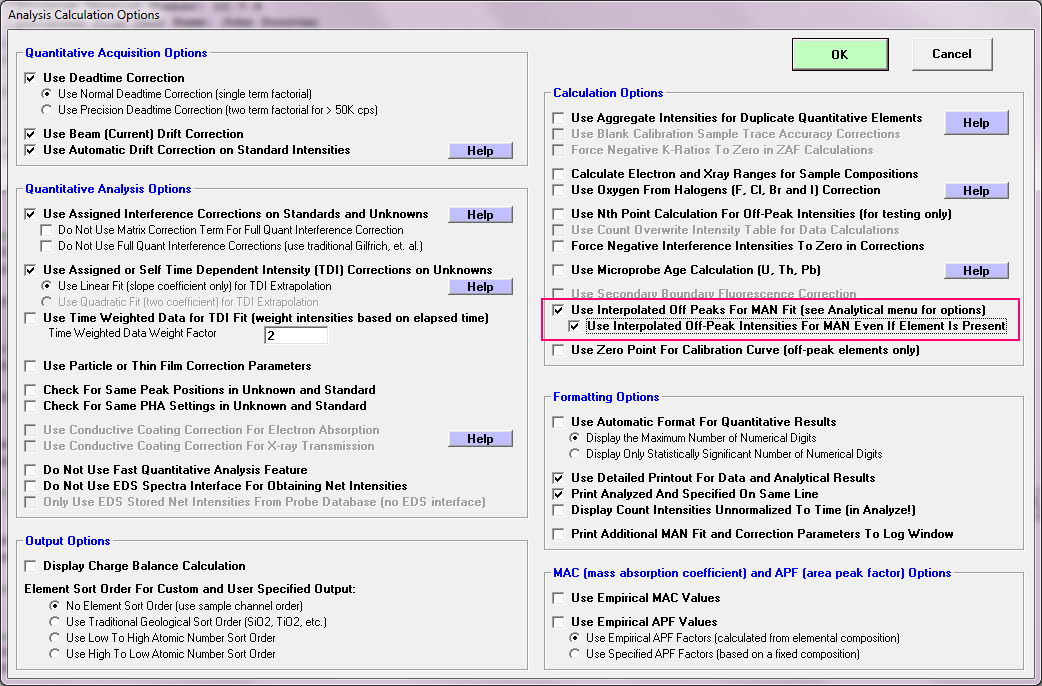I am not a coder, but from a user perspective it seems like maybe a stern pop-up warning when un-checking the 'use interpolated off peak' might be enough to get the risk across? If that were ignored or didn't exist, as you say as soon as one looked at their 'Assign MAN Fits' hopefully it would be pretty obvious that something was deeply awry. And even if you ignored that, your results should really make introspection unavoidable?
Hi Phil,
OK, I think have something that will work. What we did was add a new checkbox to the Analysis Options dialog as seen here along with the original Use Interpolated Off-Peaks For MAN Fit checkbox:

This new checkbox is called Use Interpolated Off-Peak Intensities Intensities for MAN Even If Element Is Present. That's a mouthful but I think it does what it says. What this new flag does is basically just ignore the MAN minimum intensity level for MAN standard assignments that is set at 100 PPM. Now the cool thing is that this new MAN fit option actually reveals several interesting problems with using off-peak intensities for determining backgrounds (off-peak or MAN!). Three separate issues actually I think. These issues have been described in detail by many of our colleagues, Mike Jercinovic and others, Julien Allaz, Karsten Goemann among them I'm pretty sure. You've probably seen them yourself as well.
So backing up a bit, when I first tried checking this new flag on some off-peak measured standards, then checked the Use Off-Peak Elements For MAN Fits menu, selected Clear All MAN Assignments, and opened the Assign MAN Fits dialog, I didn't know what I expected to see, but here is the first MAN fit that displayed which is the Ca Ka MAN fit:

Well heck, it's not a great fit but considering that all the circled standards contain at least some Ca, it did a pretty good job. I learn something new every day, thanks to sharp, young guys like you!
Now one could argue that some of those high outliers are a little too much outside of statistics (I should have turned on the error bars option when I captured this image!), but let's not worry about it and go to another emission line, this time K Ka and this time there's definitely a high intensity outlier for the orthoclase standard, which of course contains 15 wt% K:

Now what could be causing this? Well there are at least two things I can think of that would cause a high outlier for off-peak measurements. First, the absorption edge effect. That is, if one of the off-peak backgrounds is on the other side of an absorption edge it might cause an under estimate or an over estimate of the continuum intensity under the peak, depending on which side of the absorption edge, the emission line of interest is on. The other reason for a high outlier is that the background is curved and we had utilized a linear fit between the off-peaks. Of course then there is the situation that if our off-peak measurement positions are on the tails of the peak (and a major peak from the element is present), we will again also be over estimating the intensity of the continuum intensity under the emission line of interest. Oh yeah, also if there is an off-peak interference, we will over estimate the on-peak continuum using off-peak measurements whether they are applied in the off-peak correction normally, or in the MAN fit as we are doing here.
All good reasons to avoid off-peak backgrounds!

Now the good news is that if we are using these MAN fits to background correct a major (and even minor) element intensity, an error of a few hundred PPM accuracy error will often be less than our on-peak intensity precision. Also for quant x-ray mapping, where we usually won't have enough precision per pixel for these sorts of background inaccuracies to matter much.
And by the way, these off-peak measurement precision errors? Well they become *accuracy* errors when using the MAN method! Why? Because we normally repeat our off-peak measurement for each data point, but the MAN background gets calibrated only once or twice in a run! So given the same average Z, the same background intensity will be estimated! And remember, the average Z precision is controlled by the *major* elements, not the continuum statistics! That's part of the reason the MAN method has higher precision than off-peak measurements. Read the 2016 Amer. Min. paper for details on this subtle issue.
And just to demonstrate that even in the case of a large concentration of the element of interest being present, there's sometimes no significant observable off-peak accuracy effects:

This standard 260 is pure synthetic Al2O3 measured at the Al Ka peak position. And while probeman did select the off-peak background positions carefully, it is still pretty good considering the intensity of the Al ka peak. At least the background in this vicinity is not curved as it is in SiO2!
So please update your PFE and try it out. One helpful hint, you can "use" your MAN intensities from older probe runs by creating a new MDB file, then making a new sample, clicking the Load File Setup button and saying "Yes" to load standard intensities. It won't import your unknowns, but it will allow to to try out this new feature on some existing standard data.
Anyway, I think this new feature should get your MAN fits going, at least until you get some more pure oxide and other synthetic standards.